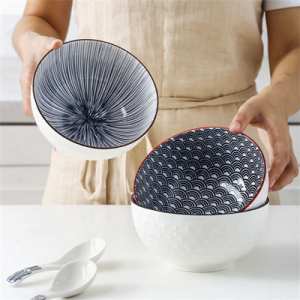Bowls, humble vessels that they are, have undergone a remarkable evolution throughout history. What began as simple containers for holding food and liquids has transformed into a canvas for culinary creativity and artistic presentation. Let’s journey through the fascinating evolution of bowls:
- Primitive Utility: Early bowls were primarily functional, fashioned from materials readily available, such as carved wood, animal hides, or woven plant fibers. These basic vessels served the practical purpose of holding food and liquids, making them an essential part of human survival.
- Ancient Innovations: As civilizations advanced, so did bowl craftsmanship. Ancient civilizations like the Egyptians, Greeks, and Romans crafted bowls from materials like clay, pottery, and metals. These bowls often featured intricate designs, reflecting cultural aesthetics and craftsmanship.
- Cultural Symbolism: Throughout history, bowls took on cultural and ritualistic significance. In various cultures, bowls were used in religious ceremonies, offerings, and rituals. Elaborately decorated bowls became symbols of status and tradition, showcasing the wealth and taste of the society’s elite.
- Medieval Craftsmanship: During the medieval period, ceramics and pottery techniques improved, leading to more durable and aesthetically pleasing bowls. Glazes and colors were introduced, allowing for greater variety in design. Bowls gained importance in medieval feasting and banquets.
- Colonial Expansion: With global exploration, materials like porcelain from China and ceramics from Persia were introduced to different regions. These exotic bowls were prized for their beauty and became collectors’ items among the elite.
- Industrial Revolution: The advent of industrialization brought mass production techniques to bowl-making. This made bowls more accessible to people of various socioeconomic backgrounds. Diverse shapes, sizes, and patterns emerged to suit different culinary needs.
- 20th Century Modernization: In the 20th century, the introduction of materials like plastics and stainless steel brought bowls into the modern kitchen. The rise of convenience foods and the emphasis on efficiency led to the design of bowls that catered to fast-paced lifestyles.
- Contemporary Culinary Artistry: In recent years, bowls have undergone a renaissance. The concept of “bowl cuisine” emerged, emphasizing the visual and sensory appeal of the culinary experience. Chefs and home cooks alike use bowls to present ingredients in artful arrangements, elevating dining into an aesthetic journey.
- Sustainable and Eco-Friendly: Today’s consciousness of environmental issues has led to a resurgence of interest in traditional materials like wood, bamboo, and clay. These materials not only evoke a sense of nostalgia but also align with sustainable and eco-friendly values.
- Technological Integration: In the digital age, technology has influenced bowl design and usage. Smart bowls equipped with sensors and digital interfaces can monitor portion sizes, nutritional content, and even connect to apps for personalized dietary tracking.
The evolution of bowls is a testament to human ingenuity and the interplay between culture, technology, and creativity. From their utilitarian origins to their modern incarnation as artistic culinary canvases, bowls continue to play a significant role in our daily lives, reflecting our changing needs and values.
















